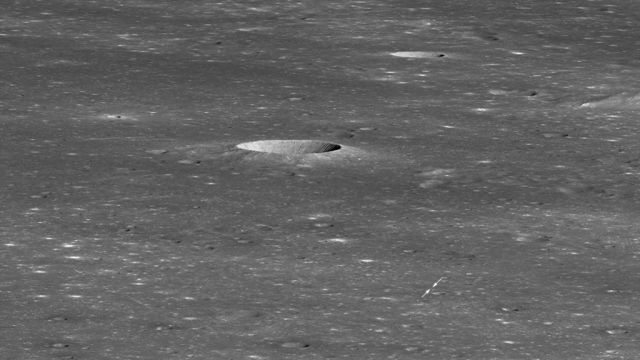On January 3, 2019, the China National Space Administration (CNSA) accomplished a human first: It successfully placed a lander on the far side of the Moon. Today, the team is revealing new insights about what they found beneath the lunar surface.
The Chang’e 4 team has released the first ground-penetrating radar study of the Moon’s far side in a new paper. The probe detected porous and granular material studded with boulders under the surface, a different kind of rock than is found on the Moon’s near side and likely the result of material dredged up by a large impact.
“There have been geophysics studies during the Apollo missions, but not with such resolution,” Elena Pettinelli, one of the paper’s corresponding authors based at the Università degli studi Roma Tre in Italy, told Gizmodo.
The CNSA first launched the Queqiao relay satellite in 2018 to the Lagrange point L2, a stable point relative to Earth and the Sun, in order to be able to communicate with the lander. The Chang’e 4 lander and its Yutu-2 rover followed, successfully becoming the first mission to touch down on the Moon’s far side, ending up in the Von Kármán crater. The experiments have been taking data ever since, and today’s new release comes from the rover’s Lunar Penetrating Radar, or LPR experiment.
The LPR works much like airborne radar, Pettinelli explained. A transmitting antennae shoots electromagnetic waves as a short burst of energy down into the ground. The waves travel until they encounter a boundary, a difference in geological properties of the rock, then some of them bounce off and return to the receiving radar while others keep descending before reflecting off of the next boundary. The study, published in Science Advances, represents an analysis of the first two lunar days (one lunar day lasts about one Earth month).
These results represent a much deeper penetration into the lunar surface than previous missions, according to the paper. The radar revealed a layer of homogenous material 12 meters down with sporadic rocks; then, from 12 to 24 meters, a layer of mostly evenly distributed rocks around 0.2 to 1 metre in diameter; and then a layer of boulders mixed in with finer material. Deeper than 24 meters were regions of were fewer rocks, with the larger ones mostly closer to the surface, as well as regions transparent to the radar, suggesting that they consisted mostly of fine-grained dirt particles.
Taken together, the radar images imply that the researchers are looking at ejecta deposits—rocks that settled onto the surface following various asteroid impacts, mixed with fine grains that accumulate over time. Tracing which rocks belong to what impacts or which craters isn’t possible, and the radar couldn’t penetrate all the way to the bottom of the regolith. Still, the researchers write, “This work shows that the extensive use of the LPR could greatly improve our understanding of the history of lunar impact and volcanism and could shed new light on the comprehension of the geological evolution of the Moon’s far side.”
These radar images are much deeper than those taken by the Chang’e 3 mission on the lunar near side, Pettinelli said. The properties of the rock on the near side made it more difficult for the radar signal to penetrate.
Bradley Thomson, research associate professor in the Department of Earth and Planetary Sciences at the University of Tennessee who reviewed the paper, thought the results were convincing and exciting, given the challenge of operating experiments on the Moon’s far side. He pointed out that the LPR provided an easy way to access the lunar subsurface, but it has its drawbacks.
“One can detect buried interfaces or rocks, but it is not always clear what those layers are, e.g., layers of impact crater ejecta, lava flow layers, etc. Here it appears that layering is related to impact processes, not volcanic layers,” Thomson said.
There’s plenty more work to do. The Yutu-2 rover operates in two frequency ranges, high and low. This paper only recounts the high-frequency data; the low-frequency data poses a processing challenge, since the rover’s body itself can muddle the radar signal. “We can go much deeper if we find a way to process the data and cancel the noise and interference from the rover on the antennae signal,” said Pettinelli.
But for now, the team has proven that their radar system is working and that it will serve as a useful tool to help uncover the history of impacts on the Moon’s far side.
